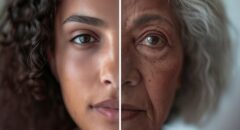
"Black don't crack" is an age-old saying that rings true in many Black families as we tend to not look like our age and our skin doesn't crack or age like other ethnic groups.
Remember the photo of the Mahomes' family? With what started out as a screen shot of a video, now has over hundreds of thousands of likes on one photo. Kaylan Mahomes posted a photo of her twin and mother, and simply labeled it “Mom, Twin & Me”. Then people from all over the world, from Zimbabwe to Thailand and Jamaica–and all kinds of races were commenting and sharing the one photo and of course had everybody guessing–which one?
Now, it's happened all over again with this picture of Cayla Beach with her sister Cheyanne Rector and mother, Nikkia Griffith. Earlier this week, the teenager (right) found herself in the center of a viral debate as Twitter followers tried to guess who was older than who.
"People usually assume my mom is in her mid to late twenties," Beach told Essence.com. "When we are in public, people always assume we are sisters and are shocked when we say that is our mother!"
Beach, who is actually only 14 years old (yes, we said 14), tells me her sister (in the black puffer coat, middle) is only 18 while her mother (in plaid) is 38 (yes, 38). But all of this Black Girl Magic begs the question -- How do we ALL keep our skin looking younger?

While black skin is slower to show the typical signs of aging like fine lines, deep forehead wrinkles, and crow's feet around the eyes, the truth is, our skin is prone to uneven tone, dark spots, hyperpigmentation, and...
... sagging -- all of which rob our skin of its youthful glow and makes us appear older than we really are.
As African American skin matures, changes in the texture of the skin become noticeable. Skin that was once baby smooth and soft becomes rough and bumpy especially on sun exposed areas. The roughness is due to skin cells that stick together and do slough as they normally would. Black skin care for this should be directed to using natural exfoliators either with topical agents, chemical peels or microdermabrasion.
A loss of volume of the skin occurs as we mature. Slow degradation of collagen in the dermal layer of the skin accounts for the loss of volume. This change leads to a hollowness of the face and sagging of the skin. The hollowness is most prominent on the cheeks just under the cheek bones. Sagging is especially prominent in the area between the nose and the outer corner of the mouth (nasolabial fold) and in the neck and jawline areas. The hollowness may be improved with the use of dermal fillers. Sagging is most readily treated with surgical a facelift.






